Originally posted on December 20, 2023 @ 4:26 pm
Welcome to our comprehensive shopping guide for using EBT at farmers markets! Farmers markets across the United States are committed to expanding access to fresh and healthy foods for SNAP recipients. Whether you’re a seasoned shopper or new to using EBT benefits, we’re here to provide you with all the information you need.
Did you know that farmers markets, authorized by the Food and Nutrition Service (FNS), accept SNAP benefits? These markets offer a wide variety of fruits, vegetables, and other nutritious foods. So, you can enjoy the benefits of shopping for fresh produce while supporting local farmers and producers.
Let’s dive into the details of how you can make the most of your EBT benefits at farmers markets and improve your diet with wholesome, locally sourced foods.
Table of Contents
Key Takeaways:
- Farmers markets across the U.S. accept EBT benefits, providing access to fresh and healthy foods for SNAP recipients.
- Authorized by the Food and Nutrition Service (FNS), these markets offer a variety of fruits, vegetables, and other nutritious foods.
- Shopping at farmers markets supports local farmers and producers while improving your diet with wholesome, locally sourced foods.
- By using EBT at farmers markets, you can enjoy the benefits of fresh produce and contribute to your community’s well-being.
- Stay tuned for the rest of our guide, where we’ll cover everything from applying to accept SNAP at farmers markets to marketing strategies for attracting SNAP customers.
How to Apply to Accept SNAP at Farmers Markets
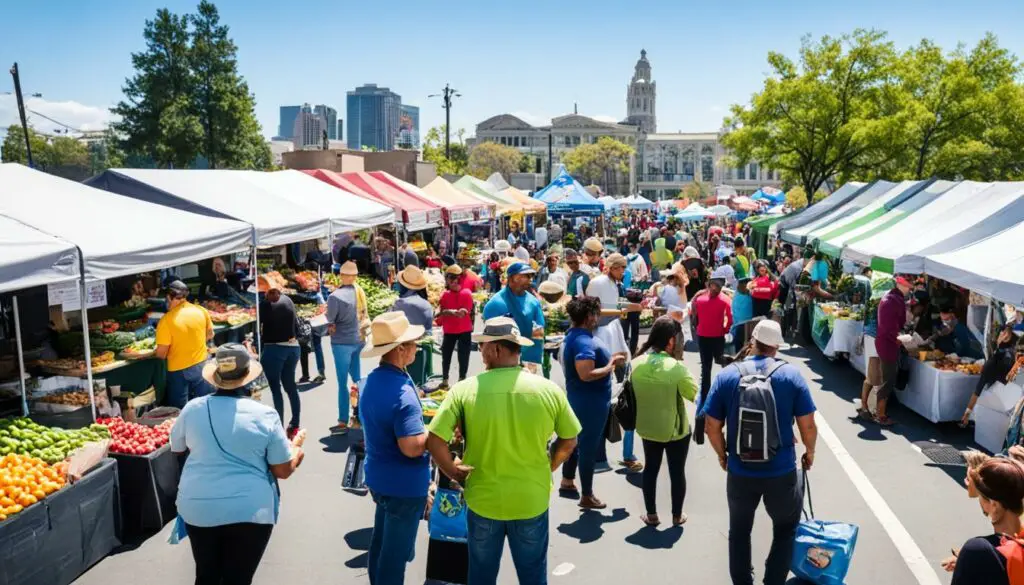
If you are the owner or manager of a farmers market, you can apply online to accept SNAP. The Food and Nutrition Service (FNS) has developed guidance to explain the application process, ensuring that farmers markets can participate in the EBT program and provide access to fresh and healthy foods for SNAP beneficiaries.
When applying, farmers markets must follow program rules and requirements set by the FNS. This includes using Electronic Benefit Transfer (EBT) equipment for SNAP transactions, ensuring a seamless and convenient shopping experience for SNAP beneficiaries. By accepting EBT, farmers markets play a vital role in supporting the nutritional needs of low-income individuals and families.
By expanding their customer base to include SNAP recipients, farmers markets not only help improve access to nutritious foods, but they also create a sustainable marketplace for local farmers and producers. This fosters community growth and supports the local economy.
EBT Equipment Options for Farmers Markets
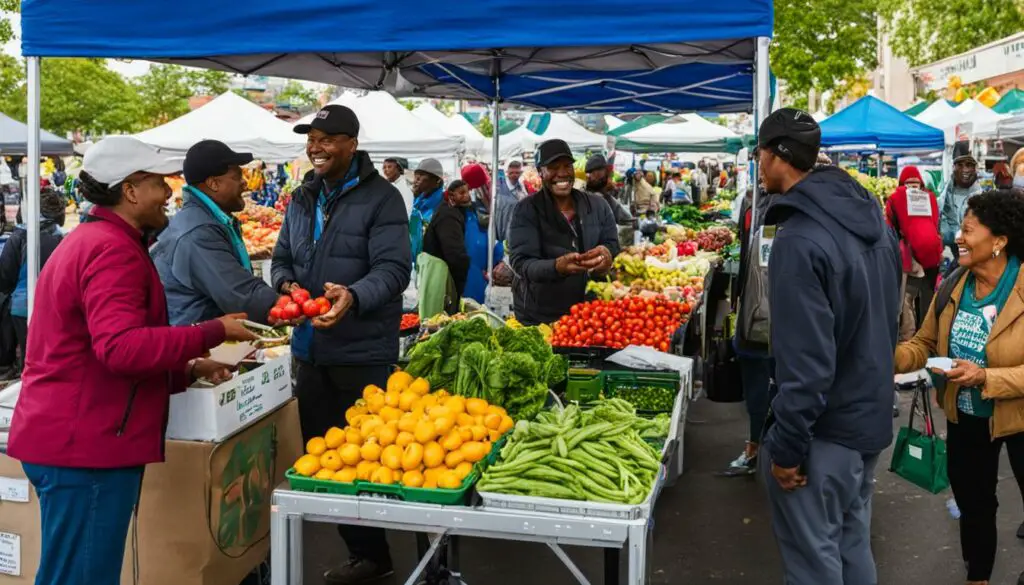
Farmers markets play a crucial role in expanding access to fresh and healthy foods for SNAP beneficiaries. To ensure a seamless shopping experience, farmers markets have various options for EBT equipment. These options allow SNAP recipients to conveniently use their benefits at the markets.
Farmers markets can choose from the following EBT equipment options:
- Smartphones and Tablets: Farmers markets can leverage the convenience of smartphones and tablets by using them as EBT terminals. With the appropriate EBT processing application, these devices can securely process SNAP transactions.
- Scrip System: Some farmers markets utilize a scrip system. This system involves issuing paper scrip, tokens, or receipts that represent the value of the SNAP benefits. SNAP recipients can then use this scrip to make purchases at the market.
- Other Approved Transaction Methods: Farmers markets may explore other approved transaction methods to accept EBT. These methods may include proprietary EBT processing systems or specialized equipment for SNAP transactions.
By offering these diverse options, farmers markets ensure that SNAP beneficiaries have access to fresh and nutritious foods, no matter their preferred method of payment. These equipment options align with the guidelines set by the FNS for EBT usage at farmers markets.
Benefits of Different EBT Equipment Options
Each EBT equipment option offers its own advantages:
“Using smartphones and tablets as EBT terminals enables farmers markets to leverage existing technology while providing a user-friendly interface for SNAP beneficiaries. The familiarity of these devices makes the purchasing process more accessible and convenient for everyone.”
Additionally, scrip systems provide a tangible form of payment, allowing SNAP recipients to easily track their remaining balance. Other approved transaction methods offer flexibility and customization to meet the unique needs of farmers markets and their communities.
Overall, these equipment options contribute to a positive shopping experience for SNAP beneficiaries and support the accessibility and utilization of EBT benefits at farmers markets.
Building Partnerships with Farmers Markets
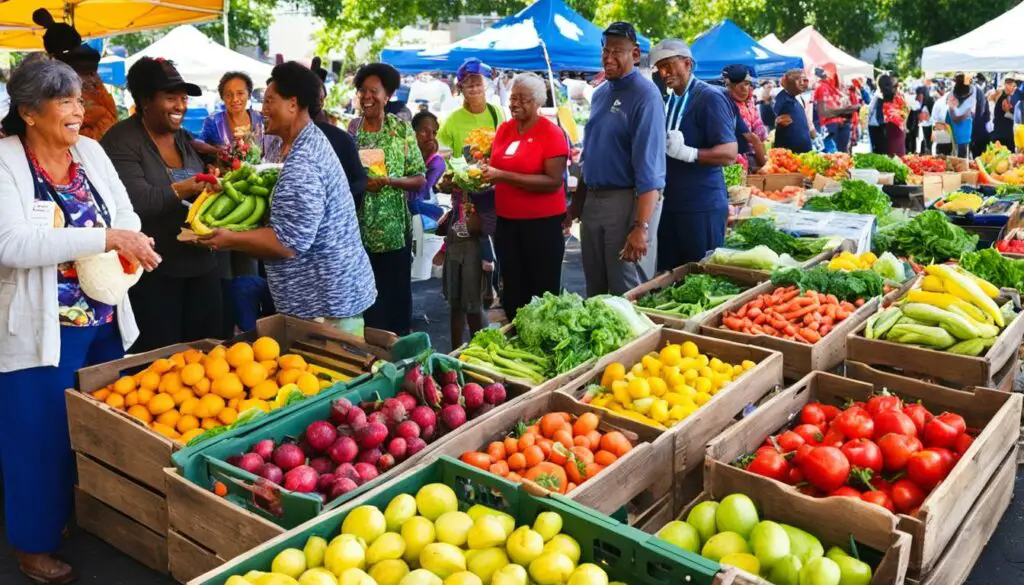
The Food and Nutrition Service (FNS) encourages partnerships between SNAP-Ed programs and farmers markets. These collaborations play a crucial role in promoting access to fresh food and supporting local agriculture. By working together, SNAP beneficiaries can enjoy the many benefits of shopping at farmers markets while learning valuable nutrition education and receiving assistance with using their SNAP benefits effectively.
These partnerships enable farmers markets to serve as more than just a place to buy groceries. They become a hub for community engagement, connecting individuals and families with local farmers and the abundance of seasonal produce.
SNAP-Ed programs offer valuable resources, including workshops, cooking demonstrations, and educational materials, to help SNAP beneficiaries make informed choices about their purchases and improve their overall well-being. By empowering individuals with the knowledge and skills to make healthier food choices, these programs contribute to the long-term health of the community.
In addition to nutrition education, SNAP-Ed programs provide assistance with navigating the EBT system at farmers markets. They help individuals understand their eligibility for EBT benefits and guide them through the process of using their benefits to access fresh and nutritious foods. This support ensures that all eligible individuals can fully utilize their benefits and reap the rewards of shopping at farmers markets.
Benefits of Partnerships with SNAP-Ed Programs:
- Improved access to fresh and healthy foods for SNAP beneficiaries
- Enhanced nutrition education and cooking skills
- Increased awareness and utilization of EBT benefits at farmers markets
- Support for local agriculture and farmers
By building partnerships with SNAP-Ed programs, farmers markets can create a welcoming and inclusive environment for SNAP beneficiaries. These collaborations empower individuals to make healthier food choices, support local farmers, and foster a sense of community. Together, farmers markets and SNAP-Ed programs play a vital role in promoting food access, health, and wellness for all.
Advertising and Marketing Strategies for Farmers Markets
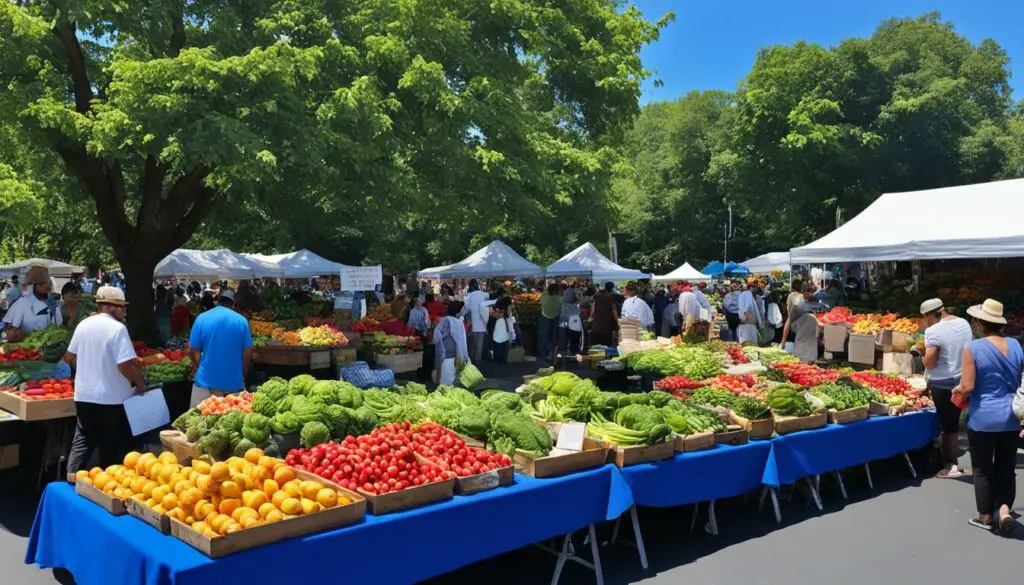
Farmers markets play a crucial role in providing access to fresh and healthy foods for SNAP recipients. To attract SNAP customers, effective advertising and marketing strategies are essential. By promoting their acceptance of the EBT program and highlighting the availability of fresh, local produce, farmers markets can increase awareness and encourage SNAP beneficiaries to shop at their market.
One effective strategy is to use signs and banners at the market entrance and throughout the market to prominently display that the market accepts EBT. This allows SNAP recipients to easily identify the markets where they can use their benefits. Additionally, farmers markets can collaborate with local organizations, such as community centers or social service agencies, to spread the word about their EBT acceptance and the benefits of shopping at the market.
Social media is another powerful tool for advertising farmers markets that accept EBT. Through regular posts and updates, markets can inform SNAP beneficiaries about the variety of fresh produce available, special discounts, and upcoming events. Encouraging customers to share their positive experiences at the market, along with photos and testimonials, can also help attract new SNAP customers.
“Shopping at farmers markets not only supports local farmers and businesses but also allows SNAP beneficiaries to access fresh, nutritious foods. By advertising their EBT acceptance, farmers markets can bridge the gap between local agricultural initiatives and the needs of SNAP recipients.”
Collaborating with local media outlets, such as newspapers, radio stations, and television channels, can further expand reach and increase visibility. Farmers markets can provide stories or news releases highlighting their EBT acceptance and the benefits of shopping at the market for both SNAP recipients and the local community in general. This can generate positive media coverage and create a buzz around the market.
In addition to advertising, engaging directly with SNAP beneficiaries at community events, health fairs, or local outreach programs can be highly effective. Setting up booths with information about the market’s EBT program and offering samples of fresh produce can create personal connections and educate potential customers about the value of shopping at farmers markets.
Overall, farmers markets can increase their customer base and support their local communities by implementing effective advertising and marketing strategies. By highlighting their acceptance of the EBT program and showcasing the availability of fresh, local produce, farmers markets can attract more SNAP customers and improve access to healthy foods.
Resources and Data for Farmers Markets
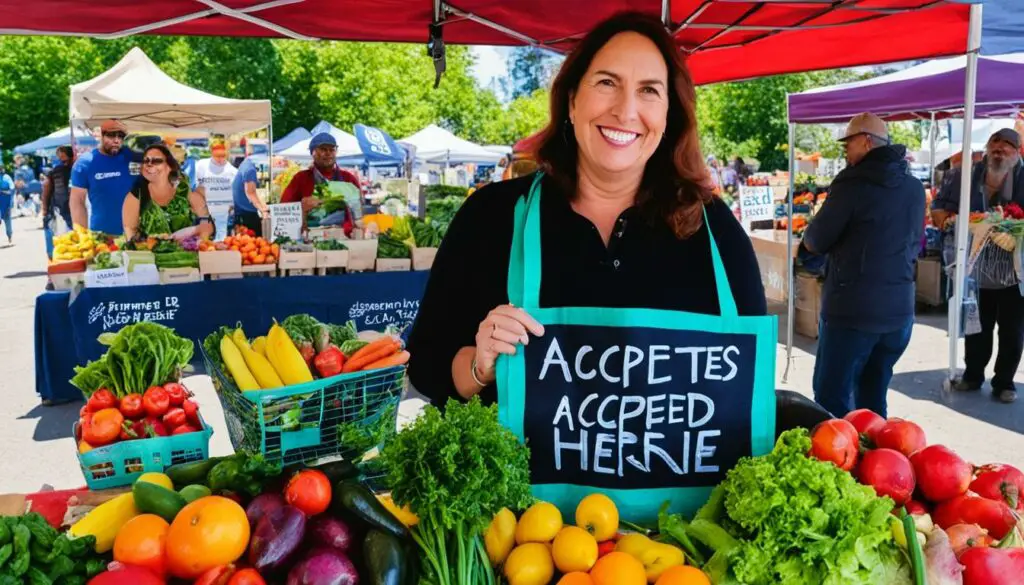
When it comes to accepting EBT at farmers markets, the Food and Nutrition Service (FNS) provides valuable resources and data to support market operators. Whether you’re looking for a comprehensive directory or insights into EBT usage, the FNS has got you covered.
If you’re searching for farmers markets that accept SNAP benefits nationwide, the FNS offers a user-friendly directory. This directory allows SNAP recipients to easily find markets in their area where they can utilize their benefits. By connecting SNAP beneficiaries with local markets, the FNS is promoting access to fresh and healthy foods for all.
| Resource | Description |
|---|---|
| EBT Accepting Farmers Markets Directory | The FNS directory lists farmers markets across the country that accept EBT. This resource helps SNAP beneficiaries locate markets in their vicinity, enabling them to enjoy fresh and nutritious food options. |
| Acknowledgements Report | The FNS periodically publishes a report that tracks EBT usage at farmers markets. This report provides valuable data on the number of EBT transactions, the types of products purchased, and other insights. Market operators can utilize this information to make informed decisions and enhance their services. |
By utilizing these resources and data provided by the FNS, farmers markets can optimize their efforts in accepting EBT and serving SNAP beneficiaries. Together, we can ensure that fresh and healthy foods are accessible to all, regardless of their socioeconomic status.
How to Get Listed in the AMS Directory

Farmers markets play a crucial role in providing fresh and healthy foods to SNAP beneficiaries. To further increase visibility and accessibility, farmers markets can get listed in the AMS directory. This directory serves as a valuable resource for SNAP beneficiaries to find farmers markets that accept EBT and promote access to nutritious food options.
Being listed in the AMS directory offers several advantages. Firstly, it enhances the market’s visibility among SNAP beneficiaries, making it easier for them to locate and visit the market. Secondly, it demonstrates the market’s commitment to supporting SNAP recipients and providing them with quality produce.
Benefits of Getting Listed in the AMS Directory
Getting listed in the AMS directory provides the following benefits:
- Increased visibility among SNAP beneficiaries
- Enhanced market credibility and reputation
- Improved accessibility for SNAP recipients
By leveraging the AMS directory, farmers markets can effectively reach their target audience and ensure that SNAP beneficiaries have access to fresh and healthy foods through the EBT program.
Take a look at the table below to understand how listings in the AMS directory can impact a farmers market:
| Benefits | AMS Directory Listing | No AMS Directory Listing |
|---|---|---|
| Increased Visibility | ✔️ | ❌ |
| Enhanced Credibility | ✔️ | ❌ |
| Improved Accessibility | ✔️ | ❌ |
Getting listed in the AMS directory is simple and can have a significant impact on the success of a farmers market. By increasing visibility, credibility, and accessibility, farmers markets can better serve their community and ensure that SNAP beneficiaries have access to fresh, nutritious foods.
Assistance Programs for Farmers and Farmers Markets
The Food and Nutrition Service (FNS) offers a participation assistance grant program specifically designed to support farmers and farmers markets. This program provides financial assistance to help them meet the necessary program requirements and expand access to fresh foods for SNAP beneficiaries. By participating in this program, farmers and markets play a vital role in promoting healthy eating habits and supporting local communities.
Farmers and markets that accept EBT at farmers markets are eligible for the participation assistance grant program. This funding opportunity aims to address financial barriers and ensure that farmers and markets can fully participate in the EBT program, helping them provide fresh and nutritious food options to SNAP beneficiaries.
Key Benefits of the Participation Assistance Grant Program
The participation assistance grant program offers several benefits to farmers and farmers markets:
- Financial Support: The program provides funding to help cover the costs associated with accepting EBT at farmers markets. This support enables farmers and markets to implement and maintain EBT equipment, ensuring seamless transactions for SNAP beneficiaries.
- Program Compliance: Participating in this grant program helps farmers and markets meet program requirements set by the FNS. It ensures that they adhere to guidelines related to SNAP transactions and reporting, which promotes accountability and transparency.
- Expanded Reach: By accepting EBT benefits, farmers and markets can reach a broader customer base, including SNAP beneficiaries. This not only increases their sales but also fosters community engagement and promotes food access equity.
Through the assistance program, farmers and markets can further their commitment to supporting their communities and promoting healthy food choices. The program’s financial support and compliance assistance empower farmers and markets to overcome barriers and effectively participate in the EBT program.
Testimonial
“Participating in the assistance grant program has been a game-changer for our farmers market. The funding has enabled us to upgrade our equipment and expand our EBT program, resulting in increased sales and customer satisfaction. We are now better equipped to serve our community and provide access to fresh and nutritious foods for all.”
– Sarah Thompson, Market Manager
Participation Assistance Grant Program Data
| Year | Funding Allocation | Number of Beneficiaries Reached |
|---|---|---|
| 2020 | $500,000 | 10,000 |
| 2019 | $450,000 | 8,500 |
| 2018 | $400,000 | 7,200 |
How to Make EBT Purchases at Farmers Markets
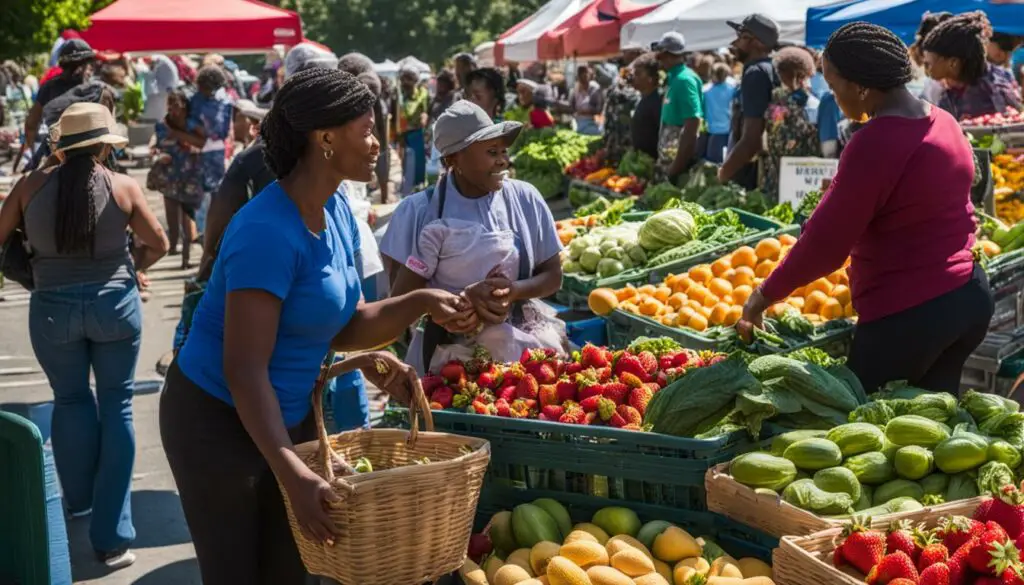
SNAP beneficiaries can make purchases at farmers markets by swiping their EBT card at a point of sale terminal or by using the SNAP mobile application and entering their PIN. This ensures a seamless and convenient shopping experience for SNAP beneficiaries.
When shopping at farmers markets with EBT, it’s important to follow the guidelines to ensure a smooth transaction. Here’s a step-by-step guide:
- Locate the EBT-authorized farmers market near you.
- Approach a vendor and select the fresh produce or eligible food items you wish to purchase.
- Present your EBT card to the vendor.
- The vendor will swipe your EBT card at their point of sale terminal or use the SNAP mobile application with an attached card reader.
- Enter your PIN on the terminal or mobile application to authorize the transaction.
- Your EBT account balance will be automatically updated, and the amount of the purchase will be deducted.
- If you have a remaining balance, you can continue shopping or save it for future purchases.
- Keep track of your EBT transactions and balances to manage your benefits effectively.
By following these simple steps, SNAP beneficiaries can access fresh and healthy foods at farmers markets while utilizing their EBT benefits.
Image: Illustration of a person using an EBT card at a farmers market.
Benefits of Using EBT at Farmers Markets
Using EBT at farmers markets offers numerous benefits for SNAP beneficiaries and supports local farmers and producers. By accessing fresh, locally sourced produce, SNAP recipients can improve their diet and overall well-being. Here are some key advantages:
1. Access to Fresh, Nutritious Food
Farmers markets are known for offering a wide variety of fresh fruits, vegetables, and other nutritious foods. SNAP beneficiaries can use their EBT benefits to purchase these wholesome options, contributing to a balanced and healthy diet for themselves and their families.
2. Support for Local Agriculture
When SNAP beneficiaries choose to shop at farmers markets, they directly support local farmers and producers. These small-scale businesses play a vital role in sustainable agriculture and the local economy. By purchasing from them, SNAP recipients help ensure the continued success and growth of these farming communities.
3. Enhanced Shopping Experience
Shopping at farmers markets provides a more interactive and engaging experience compared to traditional grocery stores. SNAP beneficiaries can directly interact with the farmers and vendors, learning about the produce, cultivation methods, and cooking tips. This not only helps build a sense of community but also empowers individuals to make informed food choices.
4. Seasonal Variety and Quality
Farmers markets offer an array of seasonal fruits and vegetables, allowing SNAP beneficiaries to enjoy the freshest and most flavorful produce available. By shopping locally, they can take advantage of the peak growing seasons and access a wider variety of crops that may not be readily available in supermarkets throughout the year.
5. Economic Savings
Shopping at farmers markets can lead to cost savings for SNAP beneficiaries. Prices at farmers markets are often competitive, and consumers have the opportunity to find affordable options while supporting local agriculture. Additionally, the direct farm-to-consumer model eliminates middlemen, reducing markups and ensuring that more income goes directly to the farmers.
6. Community Connection
Farmers markets serve as community gathering spaces, bringing people together to celebrate local food, culture, and traditions. By shopping at these markets, SNAP beneficiaries can connect with their neighbors, build relationships with local farmers, and feel a sense of belonging within their community.
To further illustrate these benefits, here is a comprehensive table showcasing the advantages of using EBT at farmers markets:
| Benefits | Description |
|---|---|
| Access to Fresh, Nutritious Food | SNAP beneficiaries can access a wide variety of fresh fruits, vegetables, and nutritious food options available at farmers markets. |
| Support for Local Agriculture | Shopping at farmers markets directly supports local farmers and producers, contributing to the sustainability of their businesses and the local economy. |
| Enhanced Shopping Experience | Farmers markets provide an interactive and engaging shopping experience where SNAP beneficiaries can interact with farmers and vendors. |
| Seasonal Variety and Quality | Farmers markets offer a wide variety of seasonal produce, ensuring SNAP beneficiaries have access to fresh and high-quality fruits and vegetables. |
| Economic Savings | Shopping at farmers markets can result in cost savings for SNAP beneficiaries due to competitive prices and reduced markups. |
| Community Connection | Farmers markets foster a sense of community by bringing people together, promoting social connections, and celebrating local culture. |
Conclusion
Farmers market acceptance of the EBT program is a crucial step in ensuring that SNAP recipients have access to fresh and healthy foods. By allowing EBT benefits at farmers markets, we support local agriculture and provide SNAP beneficiaries with the opportunity to improve their diet and overall well-being.
By shopping at farmers markets, SNAP recipients can enjoy a wide variety of fruits, vegetables, and other nutritious foods. These markets not only provide access to fresh produce but also support local farmers and producers, creating a sustainable and thriving community.
It is essential for farmers markets to continue accepting EBT and promoting access to nutritious food options. This commitment to inclusivity ensures that everyone, regardless of their financial situation, has the opportunity to make healthy choices for themselves and their families. By bridging the gap between farmers and SNAP beneficiaries, we can build a stronger and more resilient food system for all.
FAQ
Do farmers markets accept EBT?
Yes, farmers markets across the U.S. are committed to expanding access to fresh and healthy foods for SNAP recipients and accept EBT (Electronic Benefits Transfer).
How can farmers markets apply to accept SNAP?
Farmers market owners or managers can apply online to accept SNAP. The Food and Nutrition Service (FNS) provides guidance to explain the application process.
What options do farmers markets have for EBT equipment?
Farmers markets can use smartphones and tablets as EBT terminals, a scrip system with paper scrip, tokens, or receipts, or other approved transaction methods for EBT transactions.
How can farmers markets build partnerships with SNAP-Ed programs?
SNAP-Ed programs provide nutrition education and assistance with using SNAP benefits at farmers markets. Farmers markets can collaborate with these programs to support SNAP beneficiaries in accessing fresh food.
How can farmers markets attract SNAP customers?
Farmers markets can promote their acceptance of EBT and highlight the availability of fresh, local produce. Effective advertising and marketing strategies increase awareness and encourage SNAP beneficiaries to shop at the markets.
What resources and data are available for farmers markets accepting EBT?
The FNS provides a directory of farmers markets accepting SNAP benefits nationwide and publishes a redemptions report that tracks EBT usage at farmers markets.
How can farmers markets get listed in the AMS directory?
Farmers markets can get listed in the AMS (Agricultural Marketing Service) directory to increase their visibility to SNAP beneficiaries and promote access to fresh and healthy foods.
Are there assistance programs available for farmers and farmers markets?
Yes, the FNS offers a participation assistance grant program to help farmers and farmers markets meet program requirements and expand access to fresh foods for SNAP beneficiaries.
How can SNAP beneficiaries make EBT purchases at farmers markets?
SNAP beneficiaries can make purchases at farmers markets by swiping their EBT card at a point of sale terminal or by using the SNAP mobile application and entering their PIN.
What are the benefits of using EBT at farmers markets?
Using EBT at farmers markets allows SNAP beneficiaries to access fresh, locally sourced produce, support local farmers and producers, and provide nutritious food options for households receiving SNAP benefits.
Why is it important for farmers markets to accept EBT?
Farmers market acceptance of EBT benefits provides an opportunity for SNAP recipients to access fresh and healthy foods, improve their diet, and support local agriculture.
Source Links
- https://www.fns.usda.gov/snap/farmers-markets-accepting-snap-benefits
- https://www.fns.usda.gov/snap/farmer-producer
- https://finance.yahoo.com/news/food-stamps-snap-ebt-farmers-113018737.html
See also:
Leave a Reply